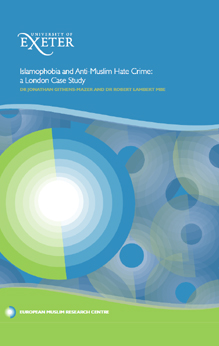
Author: Jonathan Githens-Mazer and Dr Robert Lambert
Publisher: European Muslim Research Centre, University of Exeter
Release Date: January 2010
Pages: 61
Source: https://tandis.odihr.pl/handle/20.500.12389/20715
The authors have dedicated their report to Yasir Abdelmouttalib, “a talented and committed PhD student, whose prospects of an exciting and productive academic career were cut short when he was brutally attacked and seriously injured by a gang of youths while on his way to Friday Jumma prayer at the London Central Mosque in June 2004. As a result Yasir was in coma for three months…as a result of brain injuries he has remained partially paralysed, partially blind, largely housebound, frequently bed-ridden, and reliant on constant nursing care provided by his family. Nevertheless, the commitment has showed before he was attacked still shines through the disabilities he has been forced to endure and he has made a small but significant recovery. We are therefore honoured to be working closely with Yasir and his family to establish ways in which we can help him recommence his academic studies and ensure that his legacy is a positive one, which serves to reduce the risk of other young Londoners becoming victims of anti-Muslim hate crime”.
The foreword by Peter Oborne rightly describes their as a “very powerful study” that exposes a shocking culture of contempt, “these violent attacks will get worse, and the anti-Islamic rhetoric will intensify, unless wider society takes action…”.
The authors note that their work “represents the beginning of a research project that is planned to investigate the adverse community impact of Islamophobia and anti-Muslim hate crimes across Europe over a ten year period”. Their research unit, EMRC, is located at the University of Exter’s Streatham Campus in South London, and it has as its core value the belief that “a growing European Muslim population makes significant and valuable contributions to the safety, prosperity and cohesion of European communities and countries and to the well being of Europe as a whole”.
The report is described as an introductory one, and that “a more detailed analysis of our London data alongside an analysis of data from other UK towns and cities will be included in our next report…which will be published in July 2010. Whereas our first report is report is concerned with highlighting the problem of Islamophobia and anti-Muslim hate crime, our follow-up report will contain detailed proposals to facilitate long term solutions”.
They note, “whereas in the past Londoners became accustomed to attacks on vulnerable victims that their assailants described as ‘Paki bashing’ or ‘queer bashing’, it is now clear that ‘Muslim bashing’ has become an anti-social and dangerous London street phenomenon in its own right. Policy makers, police, public servants generally and academics owe it to Muslim victims and their families to analyse and response to the threat effectively.”
The authors observe that the motivation of anti-Muslim hate crimes stems from four sources: Islamophobic, negative and unwarranted portrayals of Muslim London as Londonistan and Muslim Londoners as terrorists, terrorist sympathizers; because perpetrators associate their victim with Osama bin Laden; the politics of the BNP, EDL and other groups in this arena; and local animosities between London street gangs and ‘Muslim’ gangs arising from a perceived threat to their lifestyle from local convert Muslims.
The authors provide a description of their research methodology, based on interviews, meetings and discussions conducted in London between September 2009 and January 2010, yielding over 150 hours of recorded or summarized interviews and discussion. There was then a two-staged transcription and “after carefully re-reading transcripts and notes line-by-line, inductively coding the documents according to themes and concepts…although still at an early stage in the process by January 2010 the researchers had assembled an index containing twenty five categories and fifty sub-categories arising from pre-established and newly emergent themes in the primary data”.
The report provides seven case studies of serious anti-Muslim hate crimes:
- Neil Lewington, a violent extremist nationalist convicted in July 2009 of a bomb plot
- Terence Gavan, a violent extremist nationalist convicted in January 2010 of manufacturing nail bombs and other explosives, firearms and weapons
- A gang attack in November 2009 on Muslim students at City University
- A gang assault in June 2004 on Yasir Abdelmouttalib
- The murder in September 2009 of Muslim pensioner, Ikram Syed ul-Haq
- A serious assault in August 2007 on the Imam at London Central Mosque
- An arson attack in June 2009 on Greenwich Islamic Centre
